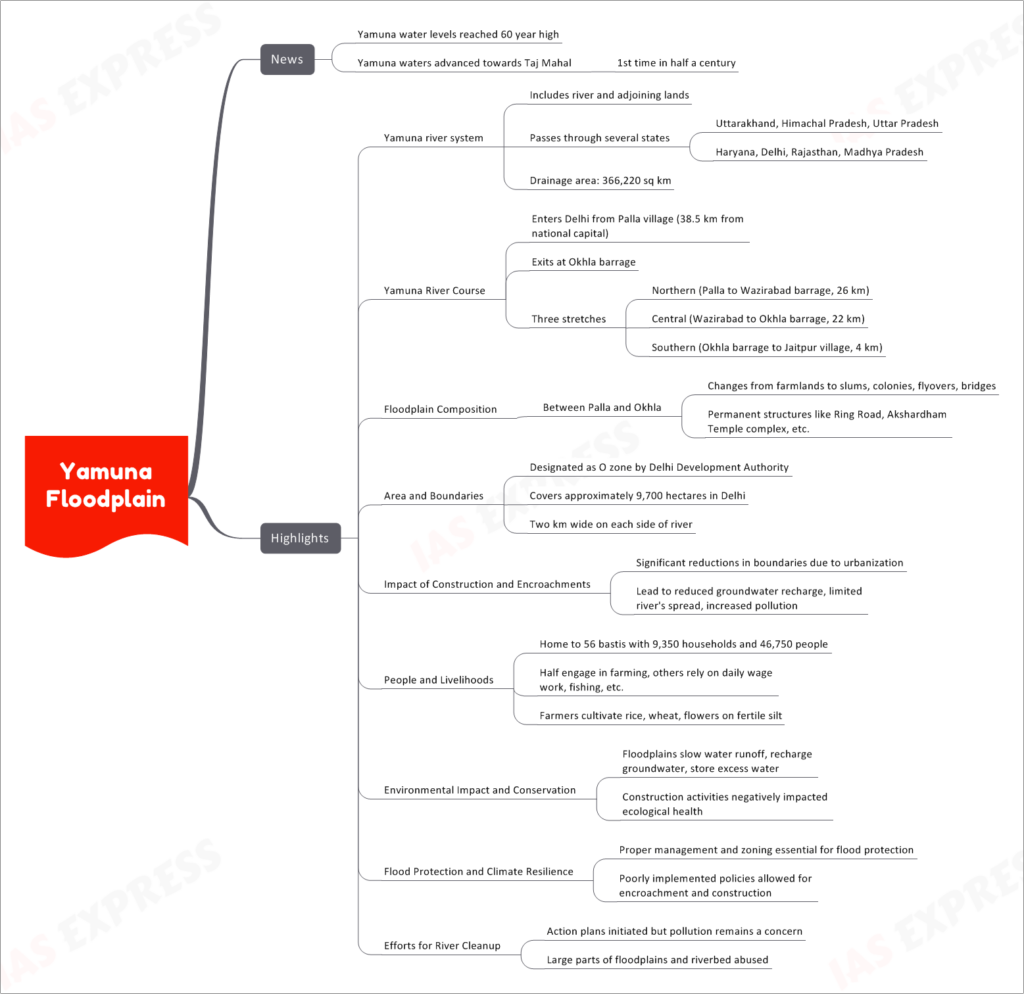Yamuna Floodplain

This topic of “Yamuna Floodplain” is important from the perspective of the UPSC IAS Examination, which falls under General Studies Portion.
News
- Recently, the water levels of the Yamuna river reached a 60-year high.
- For the first time in half a century, the Yamuna waters advanced towards the iconic Taj Mahal.
Yamuna River System
- The Yamuna river system includes the river and its adjoining lands.
- The river passes through several states: Uttarakhand, Himachal Pradesh, Uttar Pradesh, Haryana, Delhi, Rajasthan, and Madhya Pradesh.
- It has a vast drainage area covering 366,220 square kilometers.
Yamuna River Course
- The Yamuna river enters Delhi from the village of Palla, which is located 38.5 km from the national capital.
- It exits Delhi at the Okhla barrage.
- The river can be divided into three stretches within Delhi:
- Northern stretch: From Palla to Wazirabad barrage, spanning 26 km.
- Central stretch: From Wazirabad to Okhla barrage, spanning 22 km.
- Southern stretch: From Okhla barrage to Jaitpur village, spanning 4 km.
Floodplain Composition
- The floodplain between Palla and Okhla undergoes various changes, ranging from farmlands to slums, colonies, flyovers, and bridges.
- It also includes permanent structures like the Ring Road and the Akshardham Temple complex.
Area and Boundaries
- The floodplains are designated as O zone by the Delhi Development Authority.
- They cover approximately 9,700 hectares in Delhi and are two kilometers wide on each side of the river.
Impact of Construction and Encroachments
- Urbanization and construction activities have significantly reduced the boundaries of the floodplains.
- This has led to reduced groundwater recharge, limited the river’s spread during floods, and increased pollution.
People and Livelihoods
- The Yamuna floodplains are home to 56 bastis (settlements) with 9,350 households and around 46,750 people.
- Half of the population is engaged in farming, while others rely on daily wage work, fishing, etc.
- Farmers cultivate rice, wheat, and flowers on the fertile silt of the floodplains.
Environmental Impact and Conservation
- The floodplains play a crucial role in slowing water runoff, recharging groundwater, and storing excess water during floods.
- However, construction activities have negatively impacted the ecological health of the floodplains.
Flood Protection and Climate Resilience
- Proper management and zoning are essential for flood protection and climate resilience.
- Poorly implemented policies have allowed for encroachments and construction on the floodplains.
Efforts for River Cleanup
- Various action plans have been initiated to clean up the Yamuna river, but pollution remains a major concern.
- Large parts of the floodplains and riverbed have been abused, leading to environmental degradation.

